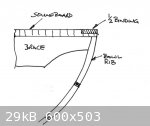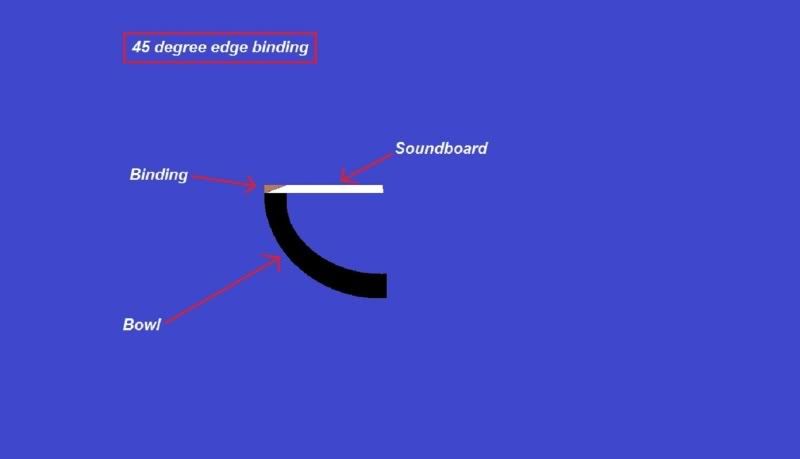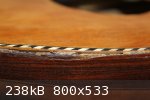Jonathan
Oud Junkie
    
Posts: 1582
Registered: 7-27-2004
Location: Los Angeles
Member Is Offline
Mood: No Mood
|
|
Face and braces
I'm about to start my third face, and I could use some input.
For those of you that make ouds, how thick are you making the faces? I am probably making mine a little too thick--2.3 mm or so. I guess I figure I
remove a bit more at the end of the job, because I always end up sanding a bit of the face at the end of the project to remove dirt, grime, and
whatever else. So, it ends up a bit thinner than that.
Is it common practice to taper the thickness from one side of the face to the other (thicker on the bass side)? I know that this is done--we have
discussed it briefly in the past. But, is it common? Did the great luthiers do this?
The braces. I love the pic that was posted a while ago by Hank Levein of the braces of the 1905 Manol. I have heard that particular oud, and it
sounds amazing. Perhaps the best sounding oud I have ever heard.
Jameel also posted pics of his brace placement. I have Jameel's first oud, and that has a very nice sound as well, and a ton of volume. More volume
than I got out of either of my first two faces (although my workmanship cannot be compared to Jameel's in any way). I guess I have attributed this at
least in part to the thickness of my faces, and perhaps to the smoothness of the inside of the bowl.
But, I really could use dimensions. How thick are the braces on older Turkish ouds? Or, on newer Turkish ouds by some of the modern greats?
Anybody have dimensions? Height? Thickness? How important is sanding them? Tapered top or left square? What is the taper on the bottom two braces
(lifting the face a little off of the level of the bowl)?
The positions of those braces that border the rosettes are all clearly defined, but what about the others? How are the positions of those braces
determined?
Are there any more pictures of the braces of ouds by classic makers--Turkish and/or Arabic? It would seem like a heck of a resource if we could get
some representative examples by different luthiers. I guess I am most interested in Manol and Kaibyan, but there is no reason not to get
representative examples of most of the great luthiers, Turkish, Arabic, Iraqi--you get the idea.
Below, 1905 Manol
|
|
|
Jonathan
Oud Junkie
    
Posts: 1582
Registered: 7-27-2004
Location: Los Angeles
Member Is Offline
Mood: No Mood
|
|
Jameel's
|
|
|
Jonathan
Oud Junkie
    
Posts: 1582
Registered: 7-27-2004
Location: Los Angeles
Member Is Offline
Mood: No Mood
|
|
Hamza, from one of Doc's threads. Manol's student, but there are a some differences from the Manol above. Hamza tapers the braces on the sides of
the central rose as the braces approach the rose.
|
|
|
Jonathan
Oud Junkie
    
Posts: 1582
Registered: 7-27-2004
Location: Los Angeles
Member Is Offline
Mood: No Mood
|
|
If anybody has some more pics, that would be great. Would love to see a Karibyan.
|
|
|
Jonathan
Oud Junkie
    
Posts: 1582
Registered: 7-27-2004
Location: Los Angeles
Member Is Offline
Mood: No Mood
|
|
I know that this thread is old, but I wanted to resurrect it because I think it could be a valuable resource if we could get some bracing patterns on
the boards.
|
|
|
suz_i_dil
Oud Junkie
    
Posts: 1061
Registered: 1-10-2008
Member Is Offline
Mood: No Mood
|
|
Hi,
I just would like to add an input on face making.
I can't help on bracing but noticed the best sounding ouds I have tried had both a half binding edge on the soundboard.
I mean the border of the soundboard is glued on the edges of the bowl and not only on the braces. Don't know if I express it clearly... I mean if you
look profile, you see clearly there is something like a millimeter of spruce between the bowl and the edges tiles.
Of course it doesn't make all, I mean the whole work was good (Faruk Turunz and Khalid Belhaiba ouds). But it is a quite unusual feature, so I thought
it worth to focus about...My "2 cents" contribution.
Good luck in your research.
|
|
|
jdowning
Oud Junkie
    
Posts: 3485
Registered: 8-2-2006
Location: Ontario, Canada
Member Is Offline
Mood: No Mood
|
|
Although a bit off topic I would like to add to suzi_i_dil's observation about half binding the sound board edging - a topic that has been discussed
on the forum in the recent past
Half binding is a traditional method of reinforcing (and decorating) both 19th C oud and 17th C lute sound board edges. The attached rough sketch
illustrates a 'half binding' arrangement in section. A ledge or rebate is cut around the edge of the face to about half the thickness (or about 0.8
mm) into which tiles or binding strips are glued. The consequent deliberate weakening of the soundboard edge has an important influence on the overall
acoustic performance of the face - as confirmed by suz_i_dil (analogous to the edge purfling of a violin belly)
Some oud luthiers today prefer to eliminate cutting a half binding edge by making the binding the full depth of the sound board (a simpler procedure).
However, I have to wonder if this practice is non traditional and has occurred because with repeated sound board removal/replacement on old ouds - a
necessary part of ongoing maintenance/repair - the material below the half binding (at the glue joint) eventually becomes so worn away that only a
full depth binding is feasible for repair?
Just a thought.
This is the situation that I am faced with in restoring an old Egyptian oud. The edge of the sound board with its original half binding is now so worn
in places that it can only be practically restored with a full depth (tile) binding

|
|
|
bulerias1981
Oud Junkie
    
Posts: 763
Registered: 4-26-2009
Location: Beacon, NY
Member Is Offline
Mood: John Vergara Luthier Lord of the Strings instrument making and repair
|
|
Jonathan,
I try to go thinner. On my first oud I did 1.6, my second out 1.7 average. My bowl on the first oud was 1.6 also. The second oud's bowl thickness is
2.0mm.
I doubt that the inside of the bowl being smooth will help with volume.
One thing I want to mention is that achieving a good sound is on every luther's mind. However, WHAT is that good sound? I have a thread I started,
(Old Oud acoustics (meaningful thread) because right now I'm trying to achieve the sound of the traditional Arabic oud without echo, and with that
percussive punchy sound. (which could have projection too. So it seems you want to achieve more volume. And is that what is considered "good
sound"?
Please better desribe other attributes to what you consider your ideal tone.
My first oud was incredibly loud, and had a lot of projection. Some might love this, and in fact, some hate this. Its also a question of what you want
the oud for.. its purpose. I bought a Fadi Matta oud a year ago in Lebanon because it was powerful and I planned on playing in an orchestra and wanted
to be heard. Some ouds sound sweet, but this sweet sound is confined to the area around the player, and doesn't push forward. Which may be good for
recording, but not for a large ensemble. I'll admit I know little about Turkish/Armenian ouds and their attributes.
I too would like to see and exchange of measurements, photos, data from oud tops. Maybe we can start a thread on that. I have some photos of bellies,
but I believe I got most of them from this forum. Another problem is, if you're going to copy a design of a belly, its good to know what the oud
sounded like before it was taken apart, or what it sounds like after construction.
It is good you have heard that Manol before the face being removed. I think it is important to even try to find a very similar material that was used
by the original maker. If Manol used spruce from the black sea, and it was in 4 or 5 pieces, and the grain on the braces is perpendicular to the face,
and also note the grain orientation of the blocks and so on. In other words try to do everything the way he did it.
jdowning,
Can you please provide some photos with instruments having half binding. I am interested in this practice. And did you say your old Egpytian oud had
this feature?
|
|
|
jdowning
Oud Junkie
    
Posts: 3485
Registered: 8-2-2006
Location: Ontario, Canada
Member Is Offline
Mood: No Mood
|
|
As requested here are some images of the 'half binding' on my old Egyptian oud. This instrument is currently undergoing restoration but you can find
more images under the topic 'Restoration of Egyptian Oud - part 1' on this forum.
Forum member Dincer Dalkilic who has been trained in the Turkish oud making tradition also uses this method I understand.
http://www.oudmaker.com.
I also used the method and demonstrated the procedure in detail on the recent 'Old Oud - New Project' topic on this forum after developing a special
plane for cutting the rebate (Search for 'half binding tool' for more information) although I suspect that most oud luthiers simply (i.e. skilfully!)
cut the rebate 'by eye' with a flat chisel (after scribing the outline with a purfling cutter).
![Old Oud Edge Banding [640x480].jpg - 34kB](https://www.mikeouds.com/messageboard/files.php?pid=81660&aid=19202)
|
|
|
bulerias1981
Oud Junkie
    
Posts: 763
Registered: 4-26-2009
Location: Beacon, NY
Member Is Offline
Mood: John Vergara Luthier Lord of the Strings instrument making and repair
|
|
Very interesting. I did see the thread about making a rebate cutter. However, I didn't realize Arab makers were doing this. I'm interested in seeing
more older Arabic instruments made this way. Maybe even a new example to test it.
|
|
|
bulerias1981
Oud Junkie
    
Posts: 763
Registered: 4-26-2009
Location: Beacon, NY
Member Is Offline
Mood: John Vergara Luthier Lord of the Strings instrument making and repair
|
|
The one issue some might have about the half binding procedure is the fact that the soundboard will be visible from the edge. Has anyone seen, heard
of or tried a 45 degree edge binding? I thought of this today, and wondered if it was in practice anywhere.
The very bottom edge of the soundboard would have to fall just slightly short of the edge of the bowl for this technique to have any meaning.

|
|
|
Matthias
Oud Junkie
    
Posts: 473
Registered: 1-24-2007
Location: Badenweiler, Germany
Member Is Offline
Mood: No Mood
|
|
hello,
find here a picture of my 1920 Gamil George having a inlay with half of the soundboard thickness'.
I would not say cutting all off comes from several repairs. Old european lutes have often been opened and I never saw an instrument where the whole
soundboard was cut off for the purfling. I would say that cutting off is due to bad craftmanship of the repair men, not by the makers himself. And
later on tha way established. This picture is a good proof for that fact too. Partly there is more glue, white modern glue to see than any wood. This
instrument is in an horrible condition at the soundboard, but I have the hope to bring it to be playable again.
Find more pictures at http://lutes-strings.de/Aoud_egypt_1920.php
Matthias

|
|
|
Yaron Naor
Oud Junkie
    
Posts: 275
Registered: 1-24-2009
Location: Bat Hefer, Israel
Member Is Offline
Mood: Happy
|
|
Natthias - the link doesn't work, can you replace it?
|
|
|
corridoio
Oud Junkie
    
Posts: 184
Registered: 3-11-2007
Location: Italy
Member Is Offline
Mood: No Mood
|
|
you have just to remove the last dot
so:
http://lutes-strings.de/Aoud_egypt_1920.php
|
|
|
Matthias
Oud Junkie
    
Posts: 473
Registered: 1-24-2007
Location: Badenweiler, Germany
Member Is Offline
Mood: No Mood
|
|
thats it and I did it, sorry
Matthias
|
|
|
jdowning
Oud Junkie
    
Posts: 3485
Registered: 8-2-2006
Location: Ontario, Canada
Member Is Offline
Mood: No Mood
|
|
Some time ago on this forum Jameel mentioned that the 'angled' described by bulerias1981 was used by at least one oud maker.
I agree with Mathias that there do not appear to be examples among the surviving European lutes where the edge banding (where applicable) was ever cut
to the full depth of the sound board - only half depth.
Are there any examples of old ouds where the edge banding was originally cut full depth (as appears to be the practice today?) and not as a
consequence of bad repair workmanship?
|
|
|
SamirCanada
Moderator
     
Posts: 3404
Registered: 6-4-2004
Member Is Offline
|
|
I am resurecting this thread in the hope some of you still have precious photographs of the old maker's bracing such as Manol and Nahat.
@samiroud Instagram
samiroudmaker@gmail.com
|
|
|
ARAKEL1
Oud Lover
 
Posts: 13
Registered: 4-24-2014
Member Is Offline
|
|
I would also like to know the bracing of a Manol Oud, more specifically the tuning to each brace. What is best tune for the braces. I am building my
first Oud. I have built my own mold based on my 1925 Arminak Derbitrossian oud that I purchased last years from Nazih Ghadban. This Oud is all of what
Nazih described, Its sound is sensational and easy to play. I have the body of the Oud built and now am trying to find info on brace tuning.
Thanks in advance.
Al
|
|
|